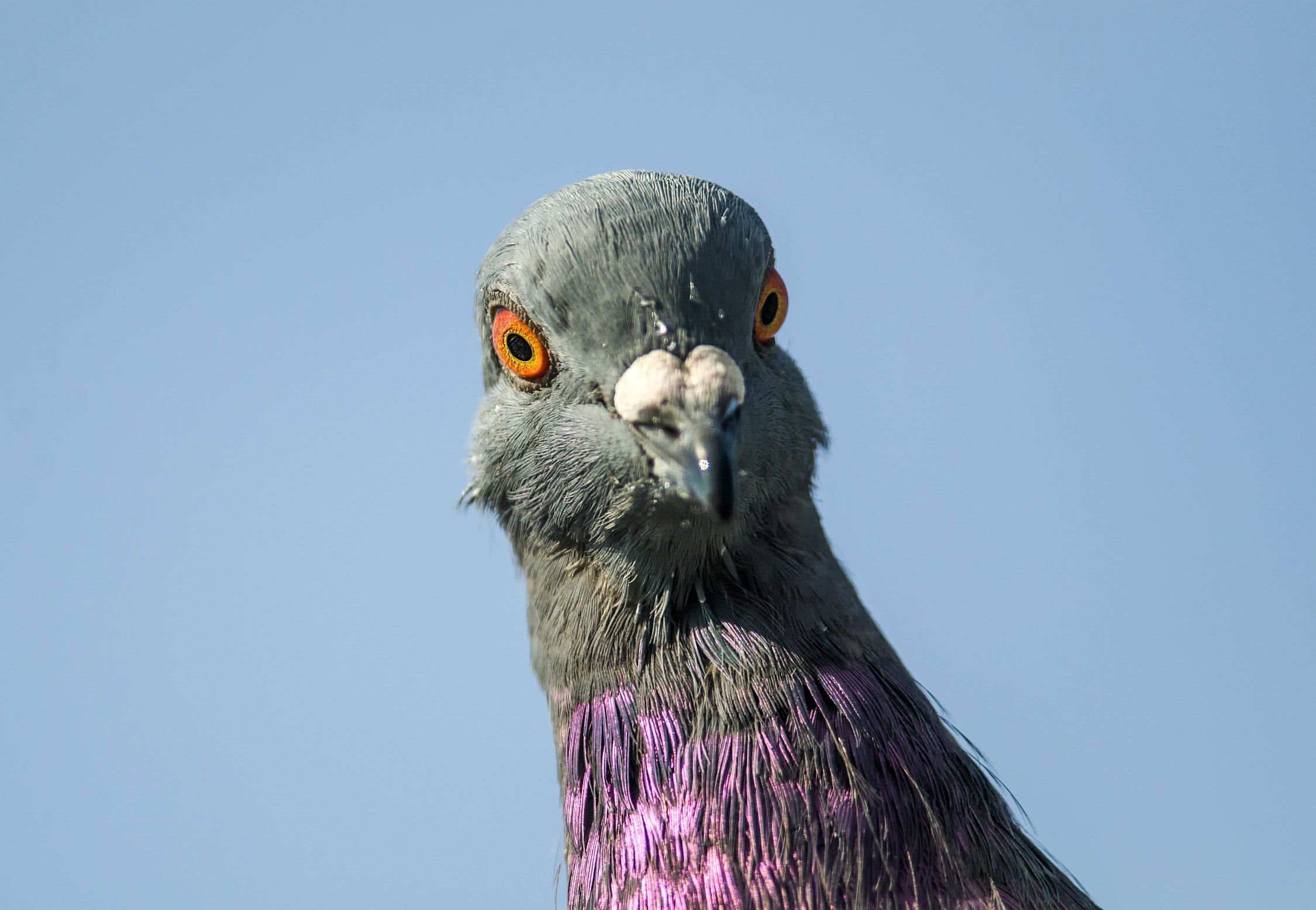
by Pigeon Patrol | Oct 3, 2019 | 4-S Gel Bird repellent, Bird Netting, Bird Spike, Bird Spikes, Pigeon Control, Pigeon Droppings, Pigeon Patrol's Services, Pigeon Spikes, Pigeons in the News
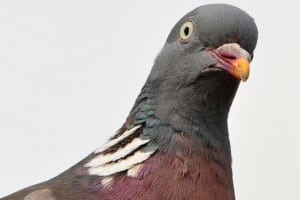
By Gordon Corera
The CIA has declassified details of its secret Cold War spy-pigeon missions.
The files reveal how pigeons were trained for clandestine missions photographing sensitive sites inside the Soviet Union.
The release also reveals how ravens were used to drop bugging devices on window sills and dolphins were trained for underwater missions.
The CIA believed animals could fulfil “unique” tasks for the agency’s clandestine operations.
Inside the CIA’s headquarters in Langley, Virginia, is a museum, sadly closed to the general public. During a visit to interview the then-director I caught sight of something unusual amid all the bugging devices and spy gadgets.
It was a model pigeon with a camera strapped to it.
The 1970s’ operation was codenamed Tacana and explored the use of pigeons with tiny cameras to automatically take photos, newly released files show.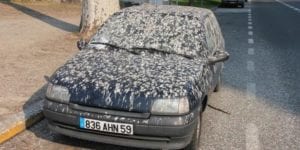
It took advantage of the fact that the humble pigeon is possessed of an amazing ability – almost a superpower. They can be dropped somewhere they have never been before and still find their way hundreds of miles back home.
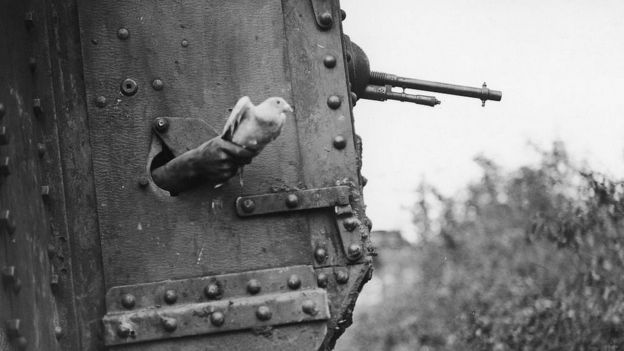
In World War Two a little known branch of British intelligence – MI14(d) – ran a Secret Pigeon Service which dropped birds in a container with a parachute over Occupied Europe. A questionnaire was attached. More than 1,000 pigeons returned with messages including details of V1 rocket launch sites and German radar stations.
Experts found that the quality of the photographs was higher than those produced by spy satellites operating at the time. One fear raised during the tests was if a member of the public stumbled upon “pigeon and camera” and assumed that the government was spying on its own, so an elaborate cover story was cooked up.
How many actual missions did the spy-pigeons fly and what intelligence did they collect? That, apparently, is still secret.

by Pigeon Patrol | Sep 1, 2019 | Bird Netting, Bird Spike, Bird Spikes, Pigeon Control, Pigeon Patrol's Services, Pigeon Spikes, Pigeons in the News, UltraSonic Bird Control

Bird feces being rubbed on a woman’s face.
NEW YORK — Bird poop for beauty?
That’s what goes into facials at a luxury spa where the traditional Japanese treatment using imported Asian nightingale excrement mixed with rice bran goes for $180 a pop.
About 100 women and men go into the Shizuka New York skin care salon, just off Manhattan’s Fifth Avenue, each month to get the treatment, which is promoted as a way to keep the face soft and smooth using an enzyme in the poop to gently exfoliate the skin.
Spa owner Shizuka Bernstein, a Tokyo native married to an American, has been offering what she calls the Geisha Facial for about five years.
“I try to bring Japanese beauty secrets to the United States,” says Bernstein, who learned the treatment from her mother.
The Geisha Facial poop treatment, while relatively rare in the United States, is no secret in Japan, where it was first used in the 1600s by actors and geishas.
“That’s why Japanese grandmothers have beautiful complexions,” says Duke Klauck, owner of the Ten Thousand Waves health spa in Santa Fe, N.M., which offers a Nightingale Facial for $129.
In this Wednesday, July 17, 2013 photo, salon owner Shizuka Bernstein mixes ingredients for what she calls a Geisha Facial at Shizuka New York skin care in New York. The facial, which Bernstein has been offering for five years, is a traditional Japanese treatment using imported Asian nightingale excrement mixed with rice bran, and goes for $180 a pop. (AP Photo/Mary Altaffer)
In this Wednesday, July 17, 2013 photo, salon owner Shizuka Bernstein mixes ingredients for what she calls a Geisha Facial at Shizuka New York skin care in New York. The facial, which Bernstein has been offering for five years, is a traditional Japanese treatment using imported Asian nightingale excrement mixed with rice bran, and goes for $180 a pop.
On a recent afternoon in Manhattan, Mari Miyoshi arrived at the sixth-floor Shizuka New York spa to try the treatment for the first time.
“I’m a stressed-out New Yorker,” the 35-year-old occupational therapist announced as she reclined on a table, relaxing amid aromas of camellia, lavender and rose.
The treatment begins with steam to open the pores and soften the skin. Cream is applied. And then comes what Bernstein calls “the nightingale part.”
She pours the cream-coloured poop, dried and finely ground, into a bowl, mixing it with the rice bran using a small spatula. She applies the potion to Miyoshi’s face with a brush, rubbing it in with her hands.
Does it smell?
“Yes, but like toasted rice,” Miyoshi says.
After about five minutes, it comes off with a foaming cleanser and Miyoshi’s face is draped in a warm, wet towel bathed in lavender and geranium essences. Finally, the grand finale — a green-tea collagen mask.
“Sooooo nice,” Bernstein says softly, looking at Miyoshi’s radiant face.
Dr. Michele Green, a Manhattan cosmetic dermatologist, says that while the nightingale facial “definitely has some rejuvenating effect, I don’t think it’s any different than, say, an apricot scrub or a mask that you could buy in a local pharmacy.”
A common misconception is that any old bird poop, even from pigeons, is used. Bernstein says only droppings from birds of the nightingale species are used because they live on seeds, producing the natural enzyme that is the active ingredient.
“We don’t do Central Park facials,” she says, “because those birds eat garbage.”

by Pigeon Patrol | Aug 25, 2019 | 4-S Gel Bird repellent, Animal Deterrent Products, Bird Deterrent Products, Bird Netting, Bird Spike, Bird Spikes, Pigeon Control, Pigeon Droppings, Pigeon Patrol's Services, Pigeon Spikes, Pigeons in the News, UltraSonic Bird Control
![Pigeons have become the latest recruits in helping researchers gather data on climate change. Scientists at the University of Birmingham in the U.K. have developed a tiny set of sensors resembling a small backpack that can be strapped onto the back of pigeons. These little sensors help researchers collect data on urban microclimates ??? the fluctuations in temperature, humidity, and winds that can have major effects on living in major cities. So where do the pigeons come from? The group works with local volunteers who raise homing pigeons. Known for their abilities to return to their nest, homing pigeons have been used as far back as Ghengis Khan to carry messages across long distances. Using homing pigeons means that the researchers are sure to get their instruments back and can download the information before sending the birds on their way to collect more data. The design of the backpack conceived to keep the safety and comfort of the birds in mind. Each weighs less than 3 percent of the pigeon???s body weight, which is the standard for bird tracking devices. Thomas???s wife sewed each backpack, going through several versions until they found the perfect fit. ???If [the pigeon owners] are not happy with any aspect of putting the sensors on their back, then they don???t have to fly their birds,??? explains Rick Thomas, the research fellow who leads the study. ???The welfare of the birds is utterly paramount.??? Thomas also pointed out several good reasons to use birds rather than something like drone technology. For one, drones are not allowed to fly freely in any area, particularly after the trouble a drone caused at Gatwick airport in December. Secondly, different technology would not be as cost effective as what???s possible with the pigeons. Thus far, the group???s band of pigeons have logged over 620 miles with their backpacks over the course of 41 flights. The hopes are that the climate data can be used by scientists to help them predict how pollution](https://i0.wp.com/metro.co.uk/wp-content/uploads/2019/03/SEI_58347567.jpg?quality=90&strip=all&zoom=1&resize=540%2C405&ssl=1)
Pigeons are helping researchers gather data on climate change. (University of Birmingham/Cover Images)
Pigeons have become the latest recruits in helping researchers gather data on climate change.
Scientists at the University of Birmingham have developed a tiny set of sensors resembling a small backpack that can be strapped onto the back of homing pigeons. These little sensors help researchers collect data on urban microclimates, including fluctuations in temperature, humidity, and winds that can have major effects on living in major cities.
The pigeons themselves come from local volunteers that raise them and who agree to work with the scientists. Pigeons are helping researchers gather data on climate change.
Known for their abilities to return to their nest, homing pigeons have been used as far back as Ghengis Khan to carry messages across long distances. Using homing pigeons means that the researchers are sure to get their instruments back and can download the information before sending the birds on their way to collect more data.
The design of the backpack conceived to keep the safety and comfort of the birds in mind. Each weighs less than 3% of the pigeon’s body weight, which is the standard for bird tracking devices. Sensors in the backpacks help researchers collect data on urban microclimates (University of Birmingham/Cover Images)
‘If [the pigeon owners] are not happy with any aspect of putting the sensors on their back, then they don’t have to fly their birds,’ explains Rick Thomas, the research fellow who leads the study. The welfare of the birds is utterly paramount and, they’re not likely to cause the same issues as drones, explained Thomas.
The pigeons all come from local volunteer groups.![Pigeons have become the latest recruits in helping researchers gather data on climate change. Scientists at the University of Birmingham in the U.K. have developed a tiny set of sensors resembling a small backpack that can be strapped onto the back of pigeons. These little sensors help researchers collect data on urban microclimates ??? the fluctuations in temperature, humidity, and winds that can have major effects on living in major cities. So where do the pigeons come from? The group works with local volunteers who raise homing pigeons. Known for their abilities to return to their nest, homing pigeons have been used as far back as Ghengis Khan to carry messages across long distances. Using homing pigeons means that the researchers are sure to get their instruments back and can download the information before sending the birds on their way to collect more data. The design of the backpack conceived to keep the safety and comfort of the birds in mind. Each weighs less than 3 percent of the pigeon???s body weight, which is the standard for bird tracking devices. Thomas???s wife sewed each backpack, going through several versions until they found the perfect fit. ???If [the pigeon owners] are not happy with any aspect of putting the sensors on their back, then they don???t have to fly their birds,??? explains Rick Thomas, the research fellow who leads the study. ???The welfare of the birds is utterly paramount.??? Thomas also pointed out several good reasons to use birds rather than something like drone technology. For one, drones are not allowed to fly freely in any area, particularly after the trouble a drone caused at Gatwick airport in December. Secondly, different technology would not be as cost effective as what???s possible with the pigeons. Thus far, the group???s band of pigeons have logged over 620 miles with their backpacks over the course of 41 flights. The hopes are that the climate data can be used by scientists to help them predict how pollution](https://i2.wp.com/metro.co.uk/wp-content/uploads/2019/03/SEI_58347563.jpg?quality=90&strip=all&zoom=1&resize=540%2C719&ssl=1)
Drones are not allowed to fly freely in any area, particularly after the trouble a drone caused at Gatwick airport in December. What’s more, drone technology would not be as cost effective as what’s possible with the pigeons.
Thus far, the group’s band of pigeons have logged over 620 miles with their backpacks over the course of 41 flights. Impressive!
Read more: https://metro.co.uk/2019/03/25/scientists-recruited-pigeons-help-stop-climate-change-9008203
Have a Pigeon Problem?
Pigeon Patrol Products & Services is the leading manufacturer and distributor of bird deterrent (control) products in Canada. Pigeon Patrol products have solved pest bird problems in industrial, commercial, and residential settings since 2000, by using safe and humane bird deterrents with only bird and animal friendly solutions. At Pigeon Patrol, we manufacture and offer a variety of bird deterrents, ranging from Ultra-flex Bird Spikes with UV protection, Bird Netting, 4-S Gel and the best Ultrasonic and audible sound devices on the market today.
Voted Best Canadian wholesaler for Bird Deterrent products eight years in a row.
Contact us at 1- 877– 4– NO-BIRD, (604) 585-9279, or visit our website at www.pigeonpatrol.ca

by Pigeon Patrol | Aug 21, 2019 | 4-S Gel Bird repellent, Animal Deterrent Products, Bird Deterrent Products, Bird Netting, Pigeon Patrol's Services, Pigeon Spikes, Pigeons in the News, UltraSonic Bird Control

Blinged out Bird!
A lot of us look at pigeons less than fondly – but clearly not all of us. A bird shelter in Arizona, USA, is looking for the owner of a pigeon found wearing a rhinestone-covered vest. The bird, now nicknamed ‘rhinestone bird’ and ‘Liberace’, was given to the Fallen Feathers rescue and rehabilitation facility for birds in Phoenix.
According to local reports, the pigeon was found by a woman in Glendale, wearing a blingy flight suit.
The woman said he wouldn’t fly away and she was afraid an animal would eat him, so she turned in the bedazzled bird to Judy Kieran – the founder of Fallen Feathers.
The bedazzled bird received instant online fame once Judy shared his picture on Facebook a week ago, in hopes of tracing his owner. Comments quickly flooded in, ranging from ‘fabulous’ to ‘fancy’ to ‘rhinestone birdy’.
“Looks like it’s maybe El Chapo’s pigeon with that fancy gold encrusted vest,” wrote one person in the comments section. “You have to name him Elvis!!!” joked another.
In fact, the lost bird received so much attention that Judy shared some better pictures later.
(We must say he’s a fabulous bird)
“Apparently he did belong to somebody, because he does keep going to cages and being as friendly as he is, he’s missing his home,” said Judy.
The search is still underway for Rhinestone Pigeon aka Liberace’s owner.
Have a Pigeon Problem?
Pigeon Patrol Products & Services is the leading manufacturer and distributor of bird deterrent (control) products in Canada. Pigeon Patrol products have solved pest bird problems in industrial, commercial, and residential settings since 2000, by using safe and humane bird deterrents with only bird and animal friendly solutions. At Pigeon Patrol, we manufacture and offer a variety of bird deterrents, ranging from Ultra-flex Bird Spikes with UV protection, Bird Netting, 4-S Gel and the best Ultrasonic and audible sound devices on the market today.
Voted Best Canadian wholesaler for Bird Deterrent products eight years in a row.
Contact us at 1- 877– 4– NO-BIRD, (604) 585-9279, or visit our website at www.pigeonpatrol.ca
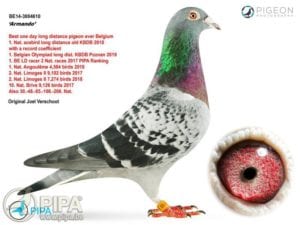
by Pigeon Patrol | Aug 21, 2019 | 4-S Gel Bird repellent, Animal Deterrent Products, Bird Deterrent Products, Bird Netting, Pigeon Patrol's Services, Pigeon Spikes, Pigeons in the News, UltraSonic Bird Control

Armando, the most expensive pigeon in the world.
A Chinese buyer bid more than $1.4 million for a prized Belgian racing pigeon in an “unprecedented” sale, according to the auctioneer that organized the sale.
The pigeon, named Armando, is considered to be the best long-distance racing pigeon “of all time” according to PIPA, the website that organized the sale. The bird has been dubbed by some as the Lewis Hamilton of racing pigeons, in reference to the Formula One racing driver.
“This type of champion is rarely offered for sale,” the site said.
The price spike came in the final hours of bidding, as two Chinese fanciers kept one-upping each other. The price went from about $600,000 to $1.4 million in about an hour, PIPA said.
Jiangming Liu, who works for PIPA in China, said the company was expecting Armando to fetch a high price but “multiple times less” than what he actually got.
“We’re all surprised,” Liu said.
PIPA said Armando is the most expensive bird ever to be sold at auction by a huge margin. The next most expensive is believed to be a bird called Nadine, which fetched more than $450,000 at auction in 2017. The buyer was a Chinese fancier named Xing Wei, according to media reports at the time.
Joel Verschoot, the Belgian breeder who put Armando up for auction, sold a total of 178 pigeons at auction for more than $2.5 million, including 7 of Armando’s offspring. He also sold a bird named Contador, which fetched more than $225,000, per PIPA.
Pigeon racing has become increasingly popular in parts of China among the country’s elite and its middle class.
Sun Yan, the deputy general-secretary of Beijing Changing District Racing Pigeons Association, said at least 100,000 pigeon breeders live in Beijing, and almost 90,000 of them are registered with Racing Pigeons Associations in different levels, to qualify for the games held in the spring and autumn.
Competitions can be lucrative for bird owners, with some prizes amounting to tens of thousands of dollars. Liu said in recent years, pigeon racing has been surging in popularity across China.
“Now other people, like regular people, are joining too,” he said. “It will be bigger in the future.”
Liu attributes the industry’s growth and increasing professionalism to a number of factors. It is the only legal bidding race in mainland China, where most forms of gambling are outlawed, and the sport is becoming increasingly accessible.
“Everyone can do it. From regular people to some rich people. Regular people buy cheap pigeons. Rich people buy expensive pigeons.”
Have a Pigeon Problem?
Pigeon Patrol Products & Services is the leading manufacturer and distributor of bird deterrent (control) products in Canada. Pigeon Patrol products have solved pest bird problems in industrial, commercial, and residential settings since 2000, by using safe and humane bird deterrents with only bird and animal friendly solutions. At Pigeon Patrol, we manufacture and offer a variety of bird deterrents, ranging from Ultra-flex Bird Spikes with UV protection, Bird Netting, 4-S Gel and the best Ultrasonic and audible sound devices on the market today.
Voted Best Canadian wholesaler for Bird Deterrent products eight years in a row.
Contact us at 1- 877– 4– NO-BIRD, (604) 585-9279, or visit our website at www.pigeonpatrol.ca








![Pigeons have become the latest recruits in helping researchers gather data on climate change. Scientists at the University of Birmingham in the U.K. have developed a tiny set of sensors resembling a small backpack that can be strapped onto the back of pigeons. These little sensors help researchers collect data on urban microclimates ??? the fluctuations in temperature, humidity, and winds that can have major effects on living in major cities. So where do the pigeons come from? The group works with local volunteers who raise homing pigeons. Known for their abilities to return to their nest, homing pigeons have been used as far back as Ghengis Khan to carry messages across long distances. Using homing pigeons means that the researchers are sure to get their instruments back and can download the information before sending the birds on their way to collect more data. The design of the backpack conceived to keep the safety and comfort of the birds in mind. Each weighs less than 3 percent of the pigeon???s body weight, which is the standard for bird tracking devices. Thomas???s wife sewed each backpack, going through several versions until they found the perfect fit. ???If [the pigeon owners] are not happy with any aspect of putting the sensors on their back, then they don???t have to fly their birds,??? explains Rick Thomas, the research fellow who leads the study. ???The welfare of the birds is utterly paramount.??? Thomas also pointed out several good reasons to use birds rather than something like drone technology. For one, drones are not allowed to fly freely in any area, particularly after the trouble a drone caused at Gatwick airport in December. Secondly, different technology would not be as cost effective as what???s possible with the pigeons. Thus far, the group???s band of pigeons have logged over 620 miles with their backpacks over the course of 41 flights. The hopes are that the climate data can be used by scientists to help them predict how pollution](https://i2.wp.com/metro.co.uk/wp-content/uploads/2019/03/SEI_58347563.jpg?quality=90&strip=all&zoom=1&resize=540%2C719&ssl=1)

